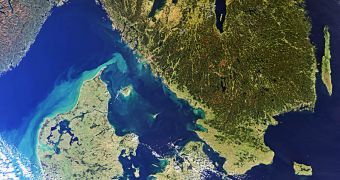Officials with the European Space Agency (ESA) announce that their CryoSat spacecraft in low-Earth orbit was able to monitor the massive storm surge that swept through northern Europe on Thursday and Friday (December 5-6) last week.
This spacecraft is part of a constellation that ESA operates to monitor variations in polar ice extent and thickness. Low Earth orbit provides an excellent vantage point for this type of precise measurements. CrySsat has a SIRAL (SAR / Interferometric Radar Altimeter) instrument for precise ranging.
The mission is operated by controllers at the ESA European Space Operations Center (ESOC), located in Darmstadt, Germany. Even though the spacecraft is designed to measure ice extents, it can also conduct a host of other scientific investigations, such as using its altimeter to measure deformations occurring in ocean water levels.
This is precisely the type of capability that was employed for monitoring last week's storm. The SIRAL instrument was used to measure how much waters in the Kattegat sea, between Denmark and Sweden, rose from their normal levels while the storm lasted. The North Sea is renowned for its wickedness.
Authorities in Europe say that the storm was one of the most massive recorded over the past few years. The event left widespread blackouts and flooding in its wake, and forced rail, road, sea and air travel to halt completely. This led to significant economic losses that the European Union plans to prevent in the future.
Unfortunately, the storm occurred as the North Sea was being swept by high tides. The intense winds and heavy rain caused a storm surge, which means that the sea rose significantly from its usual levels. Part of the German city of Hamburg were flooded, and the United Kingdom reported the highest water levels since the 1953 North Sea Floods.
“Even a small improvement to a storm surge model can have a significant impact in terms of the accuracy of warnings, and the potential to protect lives and property,” explains researcher Kevin Horsburgh, who holds an appointment with the National Oceanography Center, in the UK.
“The importance of realistic storm surge models was recently demonstrated by the devastation caused by Typhoon Haiyan in south Asia, where over 5900 people lost their lives in the Philippines alone,” ESA officials say in a statement.

 14 DAY TRIAL //
14 DAY TRIAL //